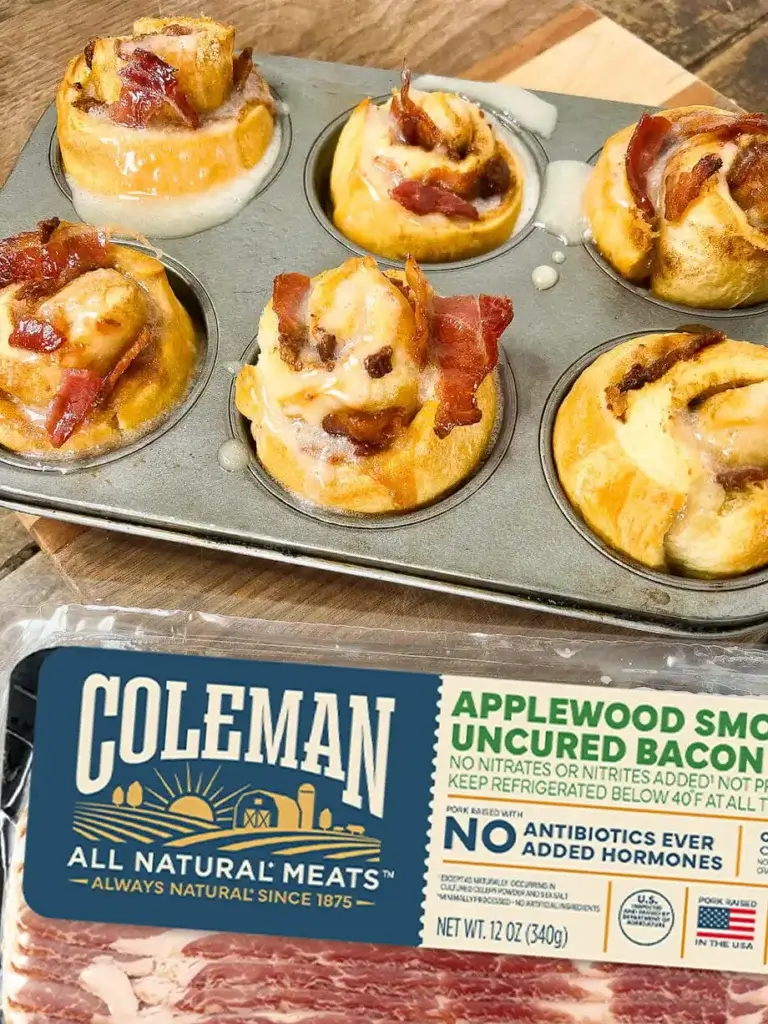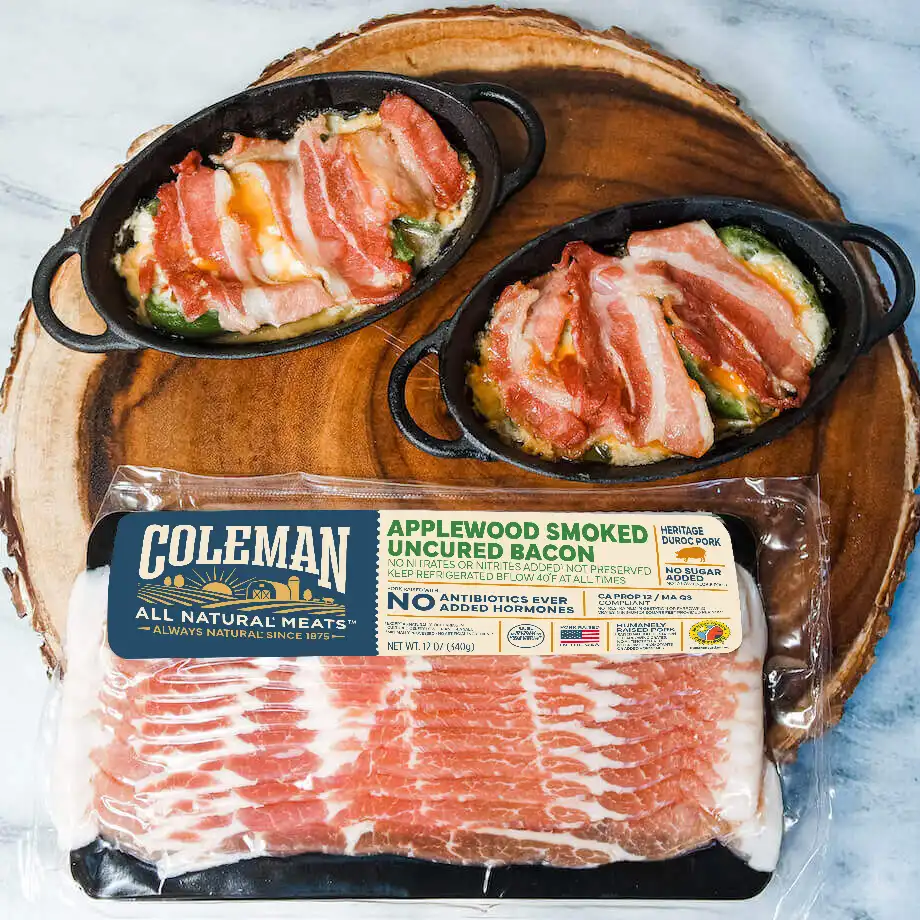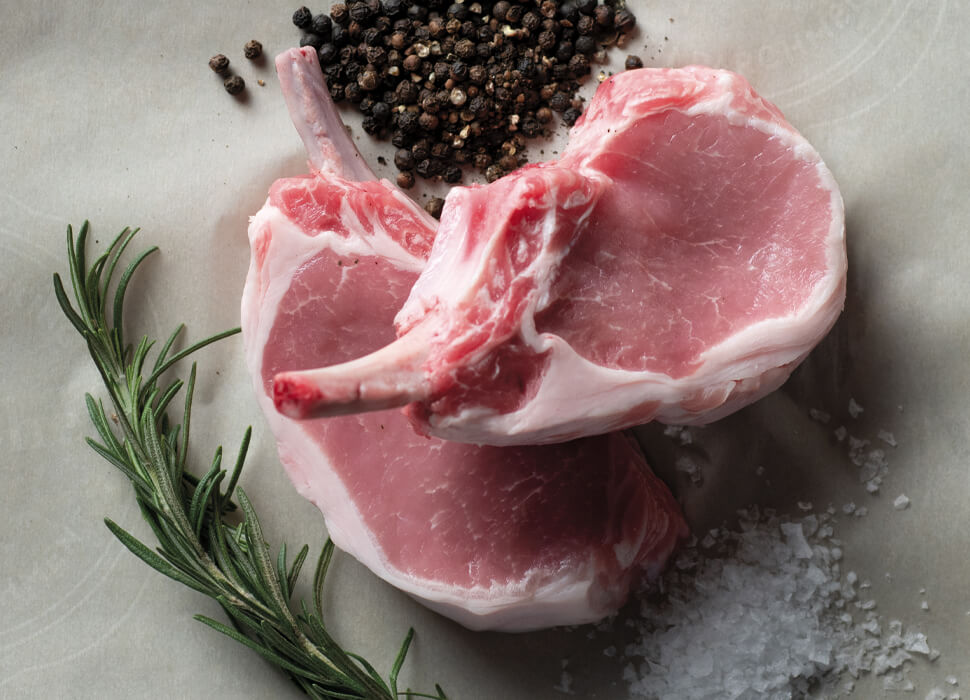Bacon is always a hit. It goes equally well nestled alongside eggs at breakfast, tucked into after-school chocolate chip cookies, or wrapped around asparagus at a dinner party. You can cook it using various methods and choose to whip up a few strips for yourself or a big batch for a crowd.
However, knowing which bacon you should buy can be a bit more difficult. Even if you know what you’re looking for, it can be confusing to decipher the differences between organic uncured bacon, nitrate-free bacon, antibiotic-free, crate-free and natural bacon.
We’ve put together a bacon buying guide to help you understand related terms and choose the best bacon for you and your loved ones.
What Is Bacon?
You know you love its savory crunch and versatility, but have you ever thought about what bacon is made of?
First off, bacon is a pork product. It’s often made from pork belly, but it can also be made from pork back. What separates bacon from stand-alone pork belly is how it’s processed.
Processors take the whole pork belly or back and place it in a curing solution that contains salt and other ingredients. The meat sits in the curing solution for anywhere from a few days to a couple of weeks before it’s removed and smoked. Once the curing and smoking process is complete, the bacon is then sliced into strips and packaged for you to enjoy at home.
Different Types of Bacon
According to the USDA, the term bacon refers to the cured belly of a hog. However, other products can be labeled as bacon as long as they contain identifying descriptors. For example, bacon made from pork shoulder must be labeled pork shoulder bacon.
Here are some types of bacon you may run into while shopping.
- Streaky bacon is what most individuals think of when they refer to bacon sold in the United States. This type of bacon is made from pork belly and contains distinct strips of marbled pink meat and white fat.
- Center cut bacon is a type of streaky bacon with fatty ends cut off.
- Thick cut bacon is streaky bacon that is cut into strips that are about twice as thick as those of “regular” bacon. These strips will take longer to cook but also result in a more satisfying and stable crunch.
- Slab bacon is cured pork belly that hasn’t been cut or trimmed. Essentially, it’s streaky bacon before it’s been further processed. Since it’s uncut, cooks can cut slab bacon into cubes, thick strips, or whatever other forms they desire. Slab bacon can be cut into matchstick shapes to form bacon lardons.
- Back bacon is made from the loin in a hog’s back. It’s less fatty than pork belly bacon and is popular in the United Kingdom.
- Dixie bacon is made from pork cheeks, aka jowls. It is also known as jowl bacon.
- Turkey bacon is made from a mixture of light and dark turkey meat that has been seasoned and formed to resemble bacon. Turkey bacon may also contain pork, but this must be noted on the product’s label.
- Pancetta is a type of Italian bacon made from pork belly. Along with being cured, it is often heavily spiced and air-dried to produce a concentrated flavor.
- Canadian bacon is made from the back of a hog. While it’s leaner than slab or center cut bacon, it undergoes a curing process that is similar to other types of bacon.
Understanding Bacon Labels
With all the different types of bacon out there, it can be difficult to distinguish between them and choose the best one for you and your family. Most food labels are governed and monitored by the USDA, which means a specific label gives you non-negotiable information about the bacon you’re buying. That said, there are overlaps between some of these labels, so don’t fall into the trap of thinking one type of bacon is necessarily better than the other.
Organic Bacon
Certified organic bacon must follow process regulations set forth by the USDA, which involve both how the animals were raised and how the product was processed.
In order to be certified organic, pigs and their mothers must have been kept in areas that allow them to express their natural behaviors. That means they must have access to the outdoors, sun, shade, and fresh air in a manner that is appropriate for their environment. This may mean farmers must provide shade in hot areas or supply a protected and enclosed shelter when the pigs are young. These pigs must also be fed all-organic feed and never given antibiotics or hormones.
When it comes time for processing, the hogs must be sent to a certified organic facility. If the meat is further processed into products like bacon, no artificial ingredients can be used. This means no artificial preservatives, colorings, or flavorings. So if you buy organic bacon, you’re also purchasing bacon that is uncured, nitrate-free, and natural.
All-Natural Bacon
According to the USDA, natural meat such as bacon must be free from added artificial ingredients. That means this type of bacon cannot contain added nitrites or nitrates, nor ingredients like sodium phosphates. Natural bacon must also be minimally processed, which means the processing “does not fundamentally alter the product.”
In the 1970s the natural meat label emerged as a way for farmers to show consumers they cared about the welfare of the animals and the quality of their products. Over time, the USDA definition changed to only refer to how a product was processed, rather than how an animal was raised. However, for Coleman Natural, the natural label still means a commitment to quality, from farm to table.

Uncured Bacon
Contrary to the label, all bacon is cured. Curing helps preserve the bacon and protect it from mold and bacteria while also making it juicy and flavorful. The difference between cured and uncured bacon lies in the ingredients that were used during the curing process.
Cured bacon—typically all bacon that doesn’t feature the uncured label—is cured using nitrates or nitrites. These synthetic ingredients help stop the spread of harmful microorganisms and also preserve bacon’s pink color. However, they may also have unintended consequences. When bacon is cooked over high heat, nitrites may convert into volatile nitrosamines, which are known carcinogens. Each consumer needs to weigh the possible health risks that arise from consuming an average amount of bacon.
Uncured bacon is cured using natural ingredients such as celery salt. These products help preserve the bacon without causing unnecessary health risks.
Nitrate-Free Bacon
If you see a nitrate-free label on bacon, don’t believe it. All bacon contains nitrates, whether or not they’re added during the curing process. That’s because natural curing agents like celery seed and celery juice both contain organic forms of nitrate.
However, you can look for labels that state that the bacon contains “no added nitrates or nitrates.” These labels appear when the bacon was cured using natural ingredients.

Sugar-Free Bacon
Bacon is known for its savory rather than sweet flavor, but that doesn’t necessarily mean bacon doesn’t contain sugar. While the pork belly is sugar-free, you’ll want to look at the ingredients used during the curing process, since some brine contains sugar along with salt and spices. While the amount of sugar added is typically minuscule, it may cause issues for those following a strict sugar-free diet.
If you’re watching your sugar intake, following a keto diet, or looking out for a diabetic family member, you should look for the bacon that sports a sugar-free label. Products like Coleman Natural’s Sugar-Free Applewood Smoked Uncured Bacon contain all of the flavors you love without any of the added sugars.
Crate-Free Bacon
Crate-free is another label that relates to how pigs were raised rather than how bacon was processed. This term refers to how pregnant and nursing sows are held during this important time in their lives.
Many pork producers utilize gestation and/or farrowing crates to contain their sows. Gestation crates are seven feet by two feet enclosures that hold sows during their approximately four-month-long gestation period. While the crates provide space for the sows to stand up and lie down, they don’t allow them to turn around.
When a sow is about to give birth, she is moved into a farrowing crate. These crates are a similar size to a gestation crate, but they are designed so piglets can access their mother to nurse. The sow still can’t turn around, nor can she closely interact with her piglets.
While gestation and farrowing crates are considered the industry standard, they aren’t the only way farmers can raise their animals. Coleman Natural farmers raise their animals crate-free, which gives them the space to express natural behaviors and interact with their young. Coleman Natural sows and piglets have 114% more space compared to those kept in industry-standard farrowing crates.
Is There Such a Thing as Grass-Fed Bacon?
While grass-fed beef labels on burgers or steaks indicate that cattle had access to pasture, the grass-fed label doesn’t belong on bacon. Why? Bacon is made from pigs, not cows.
Unlike cows, pigs’ natural diet consists of a diverse array of items, including nuts, seeds, fruits, herbaceous plants, and even insects. While grass may make up a small portion of their diet, an all-grass diet would prove detrimental to a pig’s health.
Therefore, if you see a grass-fed label on a package of bacon, it’s an indicator the product is made from beef rather than pork.
How to Select Bacon
Once you’ve figured out the type of bacon you’d like to purchase, it’s time to pick out your meat. First, seek out a product you can trust! Coleman Natural maintains high standards for how their animals were raised, how the farmers are compensated, and how products are processed. That means no added hormones, a strong network of family farmers, and no artificial ingredients. Even as the USDA has changed their bacon standards over time, Coleman Natural has held steadfast in offering a high-quality product you can believe in.
When it comes time to pick up some bacon, look at how it is stored. If you’re buying fresh bacon, ensure the meat is kept in a properly-refrigerated area, and check to see that frozen bacon is fully frozen.
When it comes to looking at individual packages of bacon, take note of printed dates. The USDA doesn’t require bacon producers to date their products, but many manufacturers choose to include a sell-by or use-by date. If you do see one of these dates on a bacon package, use them as guides. Avoid purchasing bacon after its sell-by date and eat the bacon within seven days after this date. Never eat bacon after its use-by date. Along with looking at the date, you’ll also want to carefully inspect the packaging to check for any holes or other indications of tampering.
Next, look for any signs that the bacon has gone bad. No matter what type of bacon you’re purchasing, it should appear pink in color. If the meat looks gray, green, moldy, or otherwise discolored, pass on buying and let the store know! it. If it looks alright, pick up the package and smell it. No smell or a smoky scent is a good sign, while sour or otherwise funky odors likely indicate the meat has spoiled.
Choose the Best Bacon
When it comes time to purchase bacon, you have lots of options. Not only do you have to decipher labels like uncured, organic, and natural, but you also need to consider the right option for you and your family. And that means finding a product that fits your values.
Coleman Hickory Smoked Uncured Bacon is natural and uncured, and it’s also produced by a company that cares. We provide support to farmers so they can raise their animals crate-free and without the use of antibiotics or added hormones.
The end result? Bacon that not only tastes great but offers all of the “good for you” options that you can feel good about… So pick up a package of Hickory-Smoked Uncured Bacon or Sugar-Free Applewood Smoked Uncured Bacon the next time you’re looking to fulfill your bacon craving.
Looking to learn more about bacon? Check out these articles next:


